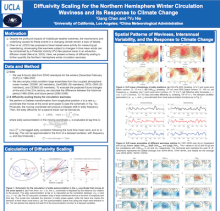An Eddy Mixing Mechanism for the Northern Hemisphere Winter Circulation Waviness
Gang
Chen
UCLA
Poster
A large latitudinal displacement of the westerly jet is often associated with atmospheric blocking and extreme events. One measure of waviness is the spatial pattern of eddy mixing in the atmosphere that regulates the distributions of dynamic and chemical tracers. Using an advection-diffusion model of passive tracers, previous analyses find that changes in atmospheric waviness under climate change can be estimated from the projected zonal wind anomalies from climate models. Here we explain the changes in atmospheric waviness with a theory of eddy mixing, which scales as eddy kinetic energy (EKE) times effective eddy time scale. The effective eddy timescale, in turn, is related to the eddy autocorrelation in the frame of reference that moves at the speed of the time mean flow. We further quantify this Doppler-shifted autocorrelation by a damped oscillator, which gives the intrinsic frequency and decay timescale of eddies. Despite the simplicity of the theory, eddy mixing can largely explain the spatial distribution of atmospheric waviness. The diffusivity scaling suggests that the effective timescale of eddies decreases with increased intrinsic frequency due to faster zonal wind speed. This is supported by the observations that the high latitude regions of enhanced waviness or blocking activity are associated with small eddy frequency, whereas the waviness or eddy mixing near the midlatitude westerly jet is suppressed by the large eddy frequency due to fast zonal jet speed. Moreover, the theory can largely capture the interannual variability of atmospheric waviness and the response to climate change in climate model simulations. The decomposition into individual components of the diffusivity scaling suggests that changes in effective eddy timescale play a key role in changes of circulation waviness. As eddy timescale is controlled by intrinsic frequency due to the Doppler shift, changes in eddy timescale provide a mechanism for the regional impacts of zonal wind changes on circulation waviness in a changing climate.

Poster file
Chen_Gang_blocking_poster (1).pdf
(746.89 KB)
Meeting homepage
